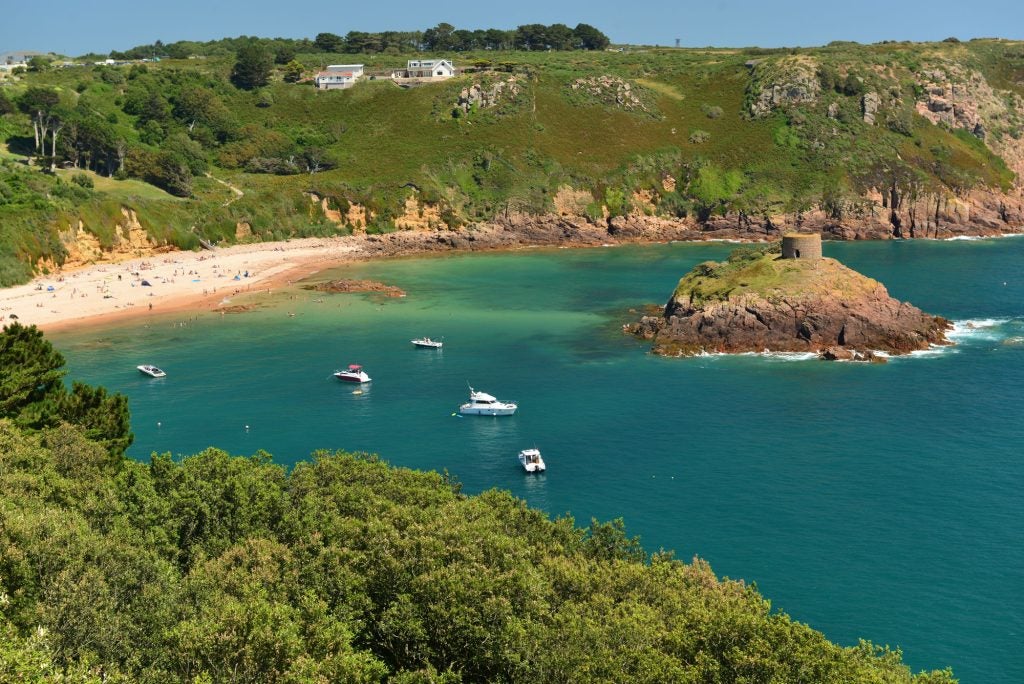
“For anyone in the travel industry, a conversation about climate change is not an easy one,” says Ports of Jersey airport director, Robin MacRae.
He’s right; the sector knows it is one of the biggest producers of CO2 emissions of all industries. In fact, research published in early 2022 revealed some truly staggering data: aviation contributes around 4% to human-induced global warming.
That figure came from a study by researchers at the University of Oxford, who also said the industry produces around a billion tonnes of CO2 each year, more than even industrialised countries such as Germany, amounting to around 2.4% of all global CO2 emissions.

Ambition takes to the skies
For its part, Ports of Jersey, which operates the harbour, ports, and airport on the island, is taking significant steps to clean the sector up; with other sustainability programmes on and around the channel island, located just off the coast of France.
Working with a relatively new entrant to the aviation sector Universal Hydrogen (UH2), which develops sustainable flight solutions through the use of hydrogen, and regional airline Blue Islands, the authority hopes to bring hydro-powered flight to some services as soon as 2025.
“UH2 are fast-tracking the decarbonisation of aviation by retrofitting existing aircraft,” says Macrae. “The fact that the Blue Islands fleet is made up of ATR regional aircraft, one of the airframes UH2 is converting; and that almost 98% of our electricity on-island is already carbon free, as it’s sourced from nuclear and hydro generation in France; almost made it a ‘no brainer’ for us to get involved in a partnership arrangement.”
How well do you really know your competitors?
Access the most comprehensive Company Profiles on the market, powered by GlobalData. Save hours of research. Gain competitive edge.

Thank you!
Your download email will arrive shortly
Not ready to buy yet? Download a free sample
We are confident about the unique quality of our Company Profiles. However, we want you to make the most beneficial decision for your business, so we offer a free sample that you can download by submitting the below form
By GlobalDataThe first offering from UH2 is a conversion kit for existing regional aircraft, namely the ATR72 – for which this partnership will see five of Blue Island’s fleet converted – and the De Havilland Canada Dash-8. It says the kit comprises a fuel cell electric powertrain that replaces the existing turboprop engines.
The company also provides the fuel by way of lightweight modular hydrogen capsules loaded to the rear of the fuselage. That power source is transported using existing intermodal freight network and cargo handling equipment, requiring limited infrastructure development from the outset.
However, not ignoring some of the challenges the project might face, MacRae says UH2 and Ports of Jersey will amend facilities and procedures to support hydrogen provision, airport ground handling and storage, operating procedures, and regulatory requirements.
“Clearly, there will be different requirements and challenges associated with the production and supply of hydrogen.”
“Clearly, there will be different requirements and challenges associated with the production and supply of hydrogen,” he says. But he also stresses this is not new technology and the storage, transport, and safety management of hydrogen has been evident in other industries for some considerable time.
MacRae says the authority sees green hydrogen as being currently the only near-term true potential zero-carbon solution for the decarbonisation of aviation, with electrification, via batteries, having significant potential for short flights.
It’s a view shared by the biggest players in aerospace. Airbus says it believes hydrogen is “one of the most promising zero-emission technologies to reduce aviation’s climate impact”. It hopes to have an airliner operational by the middle of the next decade. Its biggest rival, Boeing, is less enthusiastic – outwardly at least – about its potential as a sustainable aviation fuel (SAF).
The collaboration between the three parties involved in the island’s project is badly needed. UH2 says if aviation is to meet its Paris Agreement emissions targets the only route is through hydrogen-powered single-aisle aeroplanes, which right now account for the majority of aviation CO2 emissions.
A clean, green future for the Channel Islands
Whilst the fuel source has huge potential, the vision of Ports of Jersey does not stop there. It says it isn’t discounting other propulsion opportunities to decarbonise aviation and has factored in the provision of SAFs as a requirement for its contracted fuelling provider.
“We are also a partner in a ‘Future Flight’ Innovate UK-funded research and development project,” says MacRae, adding it has the potential to provide inter-island connectivity across the channel isles using services like electric air taxis. The £125m project, running to 2024, aims to transform aviation through electric, hydrogen and autonomous air vehicles.
The mission to secure sustainability at every opportunity is one the island, and in particular its transportation infrastructure, takes seriously. “The aircraft and ships that provide us with critical connectivity are also greenhouse gas polluters,” MacRae continues.
“To decarbonise travel, all parts of the supply chain need to coordinate to take meaningful action – including manufacturers, fuel suppliers, airlines, ferry operators, airports, harbours, governments, and others.”

In early 2022 Ports of Jersey published the “Ports Planet and People Plan”, setting out what it says is an ambitious series of goals to tackle the growing climate emergency; the threat to local biodiversity; how to manage waste generated by it, passengers and partners; and its commitment to employees and the community.
MacRae says the initiative will be employee-led, as they are the “experts on our organisation”, proving that with their knowledge, insights, and “sheer enthusiasm for what they’ve created”.
An example of some of the work being done is a project to restore, and prevent further damage to Jersey’s largest area of seagrass at St Catherine’s Bay. Seagrass is known for its blue carbon, calculated to absorb 35 times more carbon than tropical rainforests. The project aims to prevent damage caused by traditional moorings and anchoring.
“Seagrass is an important nursery habitat for many species. It provides coastal protection and helps oxygenate the ocean,” MacRae says. It also absorbs and sinks carbon, mitigating the impact of climate change.
“We believe that the best way we can help build the future that Jersey deserves is by taking a leading role in developing a sustainable future for our island.”
There are a plethora of other initiatives currently underway, from working to minimise the impact flight routes have on the environment, to introducing new technologies for newer, quieter, higher-performance and more efficient aircraft. The strategy is a cross-discipline framework that considers all elements of sustainability and creates a holistic approach.
“We believe that the best way we can help build the future that Jersey deserves is by taking a leading role in developing a sustainable future for our island and tackling the challenges this brings head-on,” MacRae says.
A significant element of that is the project that Ports of Jersey, UH2, and Blue Island have embarked on. MacRae believes there are huge opportunities to use green hydrogen as a substitute for hydrocarbon propulsion in both the aviation and maritime sectors:
“We are committed to taking meaningful action that makes a difference, our collaboration with UH2 and Blue Islands is one example of that commitment.”
He thinks hydrogen-powered flights are also possible: “There are steps to take, but we want to be part of the journey towards truly sustainable aviation.”



